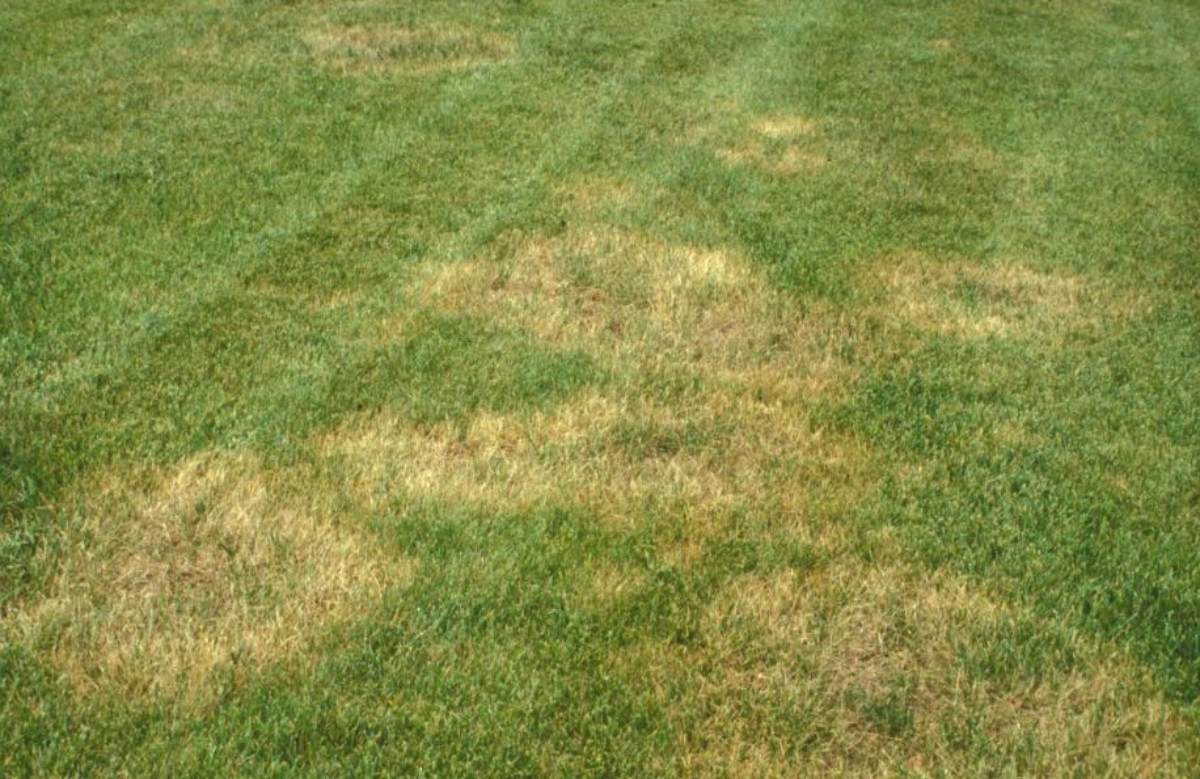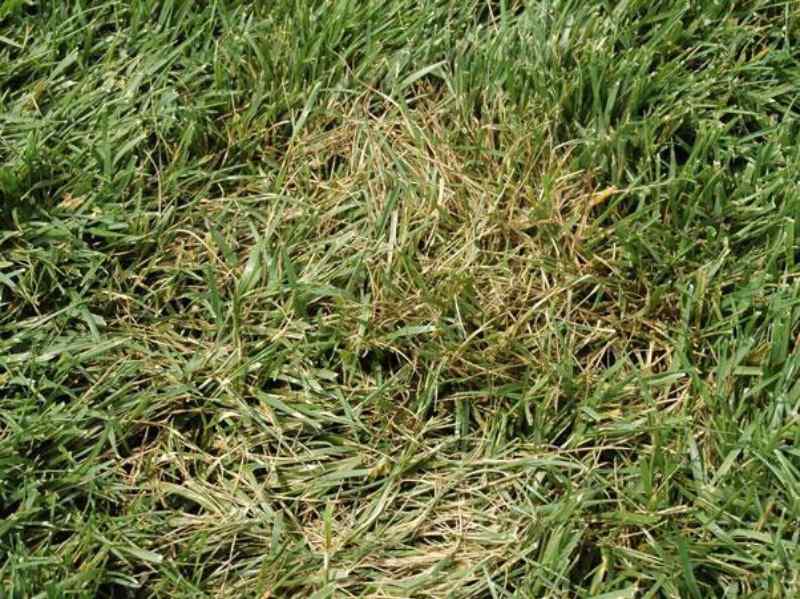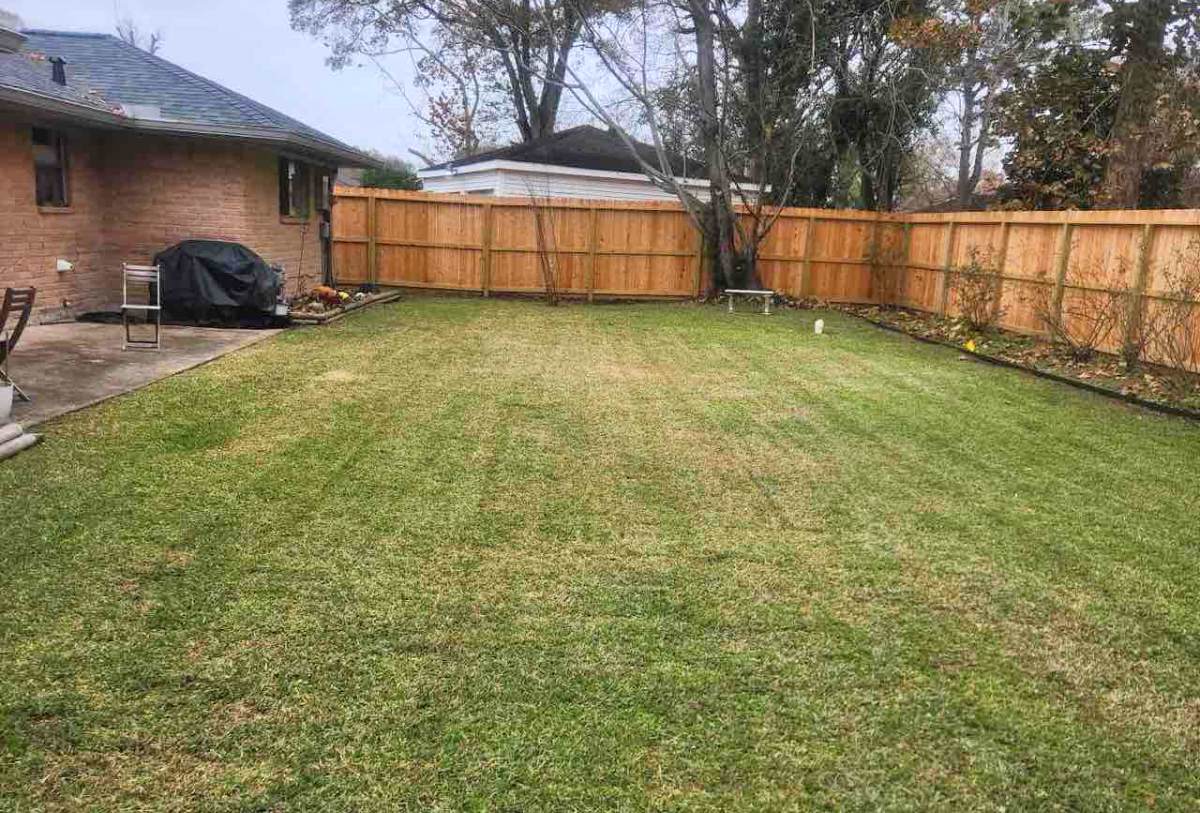
Brown patch is a cool-season lawn disease caused by the Rhizoctonia solani fungus. It causes large, circular-shaped patches of brown grass on your lawn, giving the disease its popular name.
Brown patch develops rapidly and typically appears in the late spring and summer, when the weather is hot and humid. Improving drainage and reducing moisture are two of the most important steps in managing brown patch, which often resolves on its own once cooler weather arrives.
Signs and Symptoms
Brown patches can appear on your lawn for a number of reasons (dog pee, drought, and heat stress). So how can you tell if the brown patches on your lawn are due to a fungal disease? We interviewed Peter Landschoot, professor emeritus and turfgrass expert at Penn State University, to help us answer this question.
Here are the tell-tale signs and symptoms of brown patch disease:
- Brown circles appear on your grass: Landschoot explains that brown patch fungus typically shows up as patches of circular, light brown grass, which can be a few inches to a few feet wide. The area in the center might recover and green up again, forming a “doughnut” shape.
- Smoky rings: These circles usually have a grey perimeter (popularly called a “smoke ring”) that is more apparent during the early morning hours.
- White mycelium (fungal threads): White fungal threads that look like leftover bits of cotton candy appear on the leaves of grass first thing in the morning.
- Tan lesions (discolored spots) on leaf blades: Irregular, light brown spots with a dark brown perimeter may appear on grass blades. According to Landschoot, this is a tell-tale sign of brown patch: “Lesions with dark brown borders are not present on dry grass and dog-pee spots.”
Signs of brown patch differ based on its severity, Landschoot says. In mild cases, the area may thin out, and the blades may have only mild browning. In more severe cases, the patches may appear dead, or the disease may spread over a large area instead of in patches.
What Causes Brown Patch Disease?

Brown patch disease is caused by the Rhizoctonia solani fungus, which is favored by extended periods of hot and humid weather. Other conditions that favor brown patch include:
- Compacted soil
- Excessive thatch
- Excessively thick lawns
- Overwatering and watering in the evening
- Cloudy weather
- Heavy dew
- Lack of airflow
- Frayed grass blades (typically caused by mowing with dull mower blades or mowing when the lawn is wet).
Where and When Brown Patch Disease Occurs
Where brown patch occurs: Brown patch occurs more commonly in areas where cool-season turf grows: northern states and states in the transition zone.
When brown patch occurs: Brown patch appears during periods of prolonged heat and humidity, when nighttime air temperatures rise above 65 F to 70 F and dew periods exceed 10 hours.
The exact time will vary according to your region’s weather. In midwestern and northern states, for example, brown patch shows up during summer. In the southernmost states, it starts in late spring and can even happen during warmer months in the winter.
What Type of Grass is Most Susceptible to Brown Patch?
Cool-season grasses are the most susceptible to brown patch, especially:
According to Landschoot, tall fescue and perennial ryegrass are the 2 grass types that are most susceptible to brown patch fungus. Occasionally, brown patch can also affect Kentucky bluegrass, but this turf tends to be more resistant to this common lawn disease.
Prevention and Treatment
You can prevent brown patch naturally by adapting your lawn care practices:
- Mow properly
- Avoid overwatering
- Perform lawn aeration to improve drainage
- Fertilize properly
- Dethatch when necessary
Some of the main ways to treat an existing brown patch problem:
- Reduce moisture, or even pause your watering routine. When the grass starts to show signs of drought stress, Landschoot recommends watering in the early morning hours so the grass can dry before nightfall.
- Improve air circulation by aerating or dethatching (if you have excessive thatch).
- Apply fungicides
- Mow higher
- Avoid fertilizing during an active brown patch problem. Landschoot says, “Do not apply nitrogen fertilizer (or only moderate amounts if needed) on turf with a known history of brown patch during summer.”
Check out our guide on How to Treat Brown Patch Disease in Your Lawn to learn more in-depth information on how to deal with this lawn fungus. If you’re dealing with a light case, your lawn can recover in as little as 2 to 3 weeks.
Pro Tip: When seeding a new lawn, use a blend of brown patch-resistant tall fescue and perennial ryegrass cultivars, Landschoot says. In areas where brown patch is common, incorporate Kentucky bluegrass and/or fine fescue into the seed mix since these are less susceptible to brown patch.
Timing is also critical: “Avoid seeding cool-season turfgrasses in summer, as young seedlings have little to no resistance to the brown patch pathogen,” he says.
FAQ
Yes, the Rhizoctonia solani fungus (which causes brown patch disease) can spread and affect other plants in your yard. It can infect other plants through contact with contaminated soil, grass clippings, or lawn care equipment.
Although brown patch can cause extensive damage, it will rarely kill the grass because this fungus doesn’t kill the turf’s crown. However, if favorable conditions are ongoing and no action is taken to treat it, brown patch can end up killing cool-season lawns.
Brown patch spreads very rapidly. The patches of wilted grass can develop within 24 to 48 hours.
The Rhizoctonia solani fungus is not known to cause infections in pets or humans. According to an article in the Indian Journal of Medical Microbiology, only 1 rare case of mycosis caused by this fungus has been reported in the scientific literature.
When to Call a Pro

Are you struggling with brown patch disease? Know that you are not alone. You can count on LawnStarter to save your lawn. Book a lawn treatment today and get your grass on the road to recovery.
Sources:
- Peter Landschoot, professor emeritus at Penn State University, University Park, PA. Personal interview.
- “A Rare Case of Human Mycosis by Rhizoctonia solani.” By microbiology experts N. Kaore, A. Atul, M. Khan, and V. Ramnani. “Indian Journal of Medical Microbiology.” July 2012. 30(3):361-3.
- “Brown Patch & Large Patch Diseases of Lawns.” By Nancy Doubrava, former HGIC Horticulture information specialist and James H. Blake, extension associate/adjunct professor at Clemson University.
- “Brown Patch Disease Causes Problems in the Landscape.” By Oklahoma State University.
- “Brown Patch in Tall Fescue Lawns: Information for Homeowners.” By Megan Kennelly, professor at Kansas State University.
- “Brown Patch – Lawns” by David Clement, extension specialist, Joseph Roberts, assistant professor and Debra Ricigliano, extension program assistant from University of Maryland.
- “Brown Patch on Turf.” By Kansas State University Cooperative Extension Service.
- “Rhizoctonia solani” by Michigan State University.
- “Turfgrass Diseases: Brown Patch (Causal Fungus: Rhizoctonia solani).” By Peter Landschoot, former professor of turfgrass science at Pennsylvania State University.
Main Image: Lawn with yellow and brown patchy grass areas. Image Credit: NC State Cooperative Extension